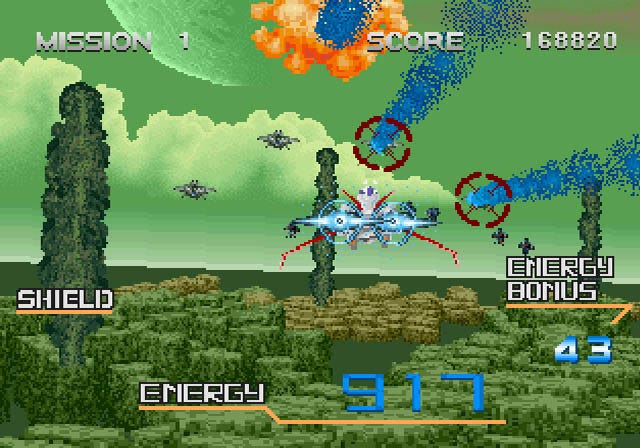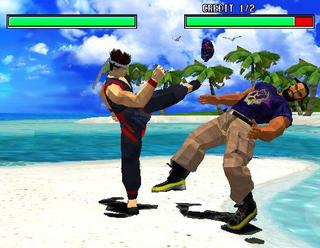How Sega and specialist emulation developer M2 created a new package of classic arcade, Master System, and Genesis titles for that take advantage of the 3DS handheld's three-dimensional screen.

Sega has been experimenting with three-dimensional games for quite a some time now. For instance, in 1988, the top-down action title Maze Walker was designed to be played exclusively with the supercool Sega-Scope 3D Glasses.
Now you can play a three-dimensional version of Maze Walker on Nintendo's 3DS that takes advantage of the handheld's 3D screen to recreate the game's unique visuals without the benefit of bulky glasses.
It's been released as part of a package called Sega 3D Classics Collection, which features 9 classic Sega titles for arcade Master System, and Genesis. All are emulated and retrofitted to add eye-popping dimensionality to the imagery--even resolutely two-dimensional titles like Altered Beast and Sonic the Hedgehog.
The package of Sega reissues was assembled by M2, a Japanese developer well-known for its lovingly made reissues of classic Sega and Konami titles. M2 is widely viewed as a company that puts a lot of love and labor into its ports.
"It’s all love here!," says Naoki Horii, president of M2. "When I was young, the games I played on consoles and in the arcades were made by developers who were at Sega. The impact those titles had on me when I was younger is something I want to make sure gets carried into the next generation in a format that will continue to impress gamers."
This well-received package of reissues give Nintendo fans a unique new perspective on classic Sega titles. It's also a great opportunity to look at the work that goes into creating this sort of enhanced reissue,
SEGA'S PARTNERSHIP WITH M2
Sega's Yosuke Okunari is similarly committed to getting Sega classics onto modern game devices. He says there are many approaches to releasing emulations of old games, which are dependent on format and constraints of the platform holder.
Some of their rereleases are straightup ports with no new features--for example, that's how they release games to fit the constraints of Nintendo's Virtual Console. But sometimes, they release enhanced remixes with new elements, tweaked difficult levels, and fresh translations.
Additionally, Okunari says that some of the games they re-release are undeniable classics that they know Sega fans are clamoring for...while others are what they dub "challenges," obscure or unsung titles that Sega cannot be sure will sell well
Sega and M2 occasionally take risks, like when they released the niche titles of the Monster World collection on Sony consoles, and invested extra effort in making them as comprehensive as possible.
The venerable publisher and reissue house collaborated to create an all-new, high-quality English localization for the unreleased-outside-of-Japan Monster World IV. The team also unearthed an English ROMset of the arcade Wonder Boy in Monster Land that they weren’t sure existed, and made sure to include that.

"I found the ROM in an old Sega warehouse near Narita airport," says Okunari. "When we ran it, it was actually functional, so we were able to put it in and release it."
This was not an appeal to a mass audience, "I’m sure that something like twenty people overseas were super happy about this obscurity," quips Okunari.
ADDING A DIMENSION TO CLASSIC 2D GAMES
The groundworks and technological knowhow that went into the stereoscopically reworked masterpieces on the Sega 3D Classics Collection were first laid when M2 began work on a 3D port of the immortal title Space Harrier. It's skillful simulation of three-dimensionality was made available as a standalone download in the 3DS online store after a lengthy development process.
"Actually, 3D Space Harrier was planned alongside a series of Game Gear reissues," says Horii. "We were trying to release the Game Gear games and the 3D Classics at the same time, but it turned out that the 3D Classics took a lot longer to not only get the compatibility worked out, but also get used to the 3DS hardware. We learned a lot about the system by doing the Game Gear ports, and that accumulation of knowledge allowed us to get Space Harrier done."

Once they had mastered a technique for adding a three dimensional perspective to classic games, the next hurdle was selecting a line-up for a packaged physical collection of games. This was partly a matter of assembling a wishlist of personal favorites, and partly a matter of making cold pragmatic decisions about the feasibility of porting.
"For the first batch of titles, we came up with a list of about 20 potential candidates," says Okunari. "Then we sent that off to M2. The initial list was based on both the local and global popularity of the titles. M2 selected the ones they thought they could do, whittling the list down to five. Some of their selection criteria was based around games they had experience porting in the past, while two were 'challenge titles' - games they’d have to devote extra R&D to in order to get them up to their standards of quality."
"The first of the 'challenge titles' was Galaxy Force II, which I was convinced was going to look amazing in 3D," says Okunari.
"The staff wasn’t convinced that they were going to be able to recreate it in 3D," says Horii. "They basically said, 'We can’t promise anything on this one.' Initially, we thought we would only be able to get it running at 30 FPS."

"The other 'challenge title' was Sonic the Hedgehog," says Okunari. "Of course, if it’s Sega, we have to do Sonic."
Both of these titles made it into the 3DS package. Unfortunately, they weren't able to even consider updating any of the classic Sega CD games for 3DS. That's just not technically feasible at present.
"We don’t really have an outlook of being able to do Sega CD ports at the moment," says Okunari."The main reason is the 68000 CPU in the Sega CD, which powers it up beyond the abilities of the 3DS to handle it."
Sega and M2 were reasonably certain that the 3DS package would find an audience since individual 3D reissues have proven to be quite popular as individual downloads.
"On Metacritic right now, Sonic 2, Gunstar Heroes, and Streets of Rage 2 are among the top-ranked 3DS titles," says Okunari. "The overseas media enjoyed the games, and we think consumers did as well. In general, the response has been great. Those three games weren’t part of the original plan, but when the initial wave of 3DS ports came out overseas, the response was very strong, so we decided to add those three titles to appeal to international audiences."
FACILITATING OTHER RE-RELEASES
Okunari says that Sega is open to helping other companies who've had successful releases on Sega's classic consoles to do 3D remakes of their games.
"During the Wii Virtual Console days, we worked with other developers and were able to port games that were on Megadrive and other Sega systems," says Okunari. "Those were all made on our side. However, negotiations with some publishers, like Capcom and Bandai-Namco, didn’t go through. We did consider negotiating again when the 3DS came along, but business-wise, nothing really came together.
For many fans, the true holy grail of reissues would be if M2 moved on from their ports of Sega's Model 2 arcade system boards to Model 3. Okunari says that there's a reason that hasn't happened yet.

The Model 3 classic Virtua Fighter 3
"This has more to do with how the teams are divided amongst Sega as a company," he notes. "Up until now, M2 has been focused on 8-bit and 16-bit ports, whereas Dreamcast and Saturn titles were done by staff that were assigned to those games from teams like AM2 or Sega of China. The idea behind that was to make these porting lines run as efficiently as possible, with the teams learning the know-how behind specific systems."
"At the time, if M2 had researched porting Model 2 or 3 on their own and come to Sega for that, we’d have told them we already had teams assigned to it, or the market isn’t right at the time. That said, that sort of corporate direction has ended recently, and M2’s is the only port line that really exists anymore. There’s a possibility that ports for Model 3 could continue on their side."
"Model 3 might actually be easier than Model 2," says Horii. "We’re obviously interested, but Sega would have to make the business call there. We’ve mostly been focusing on getting Game Gear and 3D Classics working, so there hasn’t really been any time to research much outside of that. If the opportunity presented itself, I’d certainly consider it."
"Over the past 11 years of the Sega Archive Project, M2 has slowly crept its way through SEGA hardware history, learning each system one by one," says Okunari. "As the hardware evolves, external chips get brought in, and the boards themselves get powered up - but a lot of the core programming is the same. Their studies are evolving along with the hardware itself. They’ve entered the 1990s, so perhaps we’ll continue along that route."
EMULATION IS THE ULTIMATE HISTORY LESSON
When asked about the most interesting things they've seen in the course of their reissue work, Okunari said that looking under the hood of classic games was a unique perspective on how games have evolved, and how developers have evolved.
"When games come out initially with hardware, they don’t really take advantage of everything the architecture has to offer," says Okunari. "The SDK might be old, or maybe a chip hasn’t been opened up yet. We’ll look through code and see inefficient processes that would be dramatically improved just a year or two later. We also see the developers evolving with the hardware itself - seeing how their approach to programming evolved."
"With Yuji Naka, you can see the different approaches he took to games as he went along and how he improved and further utilized. Seeing that evolution from system to system and game to game is really fascinating."
About the Author(s)
You May Also Like








